- 1 Books
- 1.1 Physics of the Plasma Universe by Anthony L. Peratt
- 1.2 The Electric Sky by Donald E. Scott
- 1.3 The Big Bang Never Happened by Eric J. Lerner
- 1.4 Cosmic Plasma by Hannes Alfvén
- 1.5 Cosmical Electrodynamics by Hannes Alfvén and Carl-Gunne Fälthammar
- 1.6 The Norwegian Aurora Polaris Expedition 1902-1903 by Kristian Birkeland
- 2 Film, video and TV
- 3 Journals
- 4 Footnotes
Books
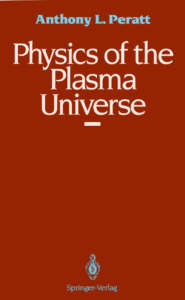
Physics of the Plasma Universe by Anthony L. Peratt
Main article: Physics of the Plasma Universe ACADEMIC BOOK
- Publ. 1992 Springer-Verlag, ISBN 0-387-97575-6 and ISBN 3-540-97575-6
- 2nd Ed. publ. Sept. 2014. ISBN 978-1-4614-7818-8. Springer.[1]
Extract
“The purpose of this book is to address the growing recognition of the need for
plasma physics in astrophysics. In fact, astrophysics has contributed to the growth of
plasma physics, especially in the field of plasma waves . During the last decade, plasma physics, or more appropriately, plasma science, has witnessed an explosive
growth in two areas : pulsed-power technology and space physics. Both have led to
knowledge that is mutual and complementary, and the material in this book largely
derives from these new discoveries and their application to astrophysics. [..]
“Today plasma is recognized as the key element to understanding
the generation of magnetic fields in planets, stars, and galaxies; phenomena occurring
in stellar atmospheres, in the interstellar and intergalactic media, in radio galaxies, in quasars, and in active galactic nuclei ; and the acceleration and transport of
cosmic rays . There are convincing arguments for the view that the clouds out of
which galaxies form and stars condense are ionized : The problem of the formation
and structure of these clouds and bodies, therefore, naturally belongs to the field of
cosmic plasmas as well as astrophysics. [..]
“Together these problems form what is called The Plasma Universe, the basis for
this book . The material presented dwell s basically on the known properties of matter
in the plasma state. Some of the interesting topics in contemporary astrophysics such
as discordant redshifts and other cosmological issues are not discussed here . The
interested reader will be referred to the IEEE Transactions on Plasma Science, Special
Issues on Space and Cosmic Plasmas (December 1986, April 1989, and February 1990), and Laser and Particle Beams (August 1988). [..]
“This book is organized into eight chapters. Chapter 1 is an introduction to the
fundamental physics of cosmic plasmas . An attempt is made to review the known
properties of plasmas from the laboratory scale to the Hubble distance. Chapter 2
starts the application of basic plasma theory to astrophysical plasmas in the study o f
magnetic-field-aligned (Birkeland) currents and charged particle beams . Chapter 3
covers magnetism in plasma and the Biot-Savart force law, while Chapter 4 concen –
trates on electric fields in space and cosmic plasmas . Chapters 5, 6, and 7 survey
double layers, synchrotron radiation, and energy transport in plasmas, respectively.
Chapter 8 covers the particle-in-cell simulation of astrophysical plasmas. Found
throughout the book are examples that apply the material of the chapter or section to
specific problems.”
The Electric Sky by Donald E. Scott
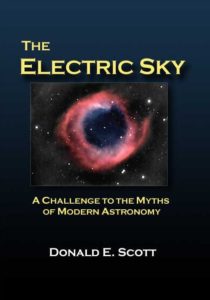
- Publ. 2006 Mikamar Publishing, ISBN 0-9772851-1-1. $25.00. Web site
Extract
- “In this book, we will look at many of the theories of present-day astrophysics and compare them to corresponding answers that have arisen from the study of electric plasma. But before we can propose any new alternative cosmology – a Plasma Cosmology to replace the presently “accepted” astrophysical and cosmological belief structure – we have to examine some of the basic problems inherent in those accepted ideas. Before we buy into any new way of looking at the cosmos, we need to ask, “What’s wrong with the old way?” To answer this, we must establish some fundamental guidelines about how a true science discovers knowledge. [..] A paradigm based on electric plasma, which does not find new discoveries to be enigmatic and puzzling but instead to be predictable and consistent, is slowly but surely gaining ground. “
|
|
The Big Bang Never Happened by Eric J. Lerner
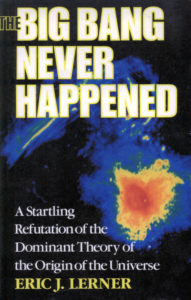
- Publ. 1991 Crown, ISBN 0812918533 (hard cover). Publ. 1992 Vintage, ISBN: 067974049X (soft cover). Buy from Amazon
Extract
“Chapter One begins with the evidence that the Big Bang theory is wrong, and that alternative theories, based on the study of electrically conducting gases, called plasmas, are probably right. [..]
“Chapter Two shows how the basic concepts of both the empirical and the deductive methods arose in ancient Greece and how they were tied up with the conflict between free and slave labor. [..]
“Chapter Three describes the next long swing of the pendulum — the centuries of struggle that led to the scientific revolution. [..]
“Chapters Five and Six describe how plasma cosmology grew out of the laboratory study of conducting gases and had its roots in the advancing technologies of electromagnetism. As observations have extended outward from the earth and the solar system to the galaxies and the universe as a whole, the predictions of plasma cosmology have been increasingly confirmed. [..]
“In Chapter Seven I examine how new discoveries in the nature of time show that such a cosmos can exist indefinitely without “running down.” [..]
“Chapter Eight looks at the equally profound problems that arise with the conventional ideas of matter if the Big Bang is refuted. [..]
“Finally, in Chapters Nine and Ten, we look at the impact an infinite cosmos has on religion and society.”
Contents
|
|
Cosmic Plasma by Hannes Alfvén
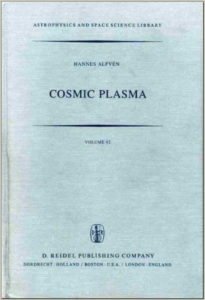
Main article: Cosmic Plasma ACADEMIC BOOK
- Publ. 1981. Astrophysics and Space Science Library, Vol. 82 (1981) Springer Verlag. ISBN 90-277-1151-8. Buy
Extract:
The aims of the present monograph may be summarized as follows:
- (1) Attention will be given to the question of how much knowledge can be gained by a systematic comparison of different regions of plasma. We will consider plasmas with linear dimensions which vary from laboratory size up to the Hubble distance.
- (2) The traditional magnetic field description of plasmas will be supplemented by an electric current description. It is demonstrated that many problems are easier to understand with a dualistic approach.
- (3) A rather strict distinction will be made between plasma regions which are accessible to in situ diagnostics and those regions which are not. In the former, we can expect to understand the plasma phenomena reasonably well, and to be able to discriminate between different interpretations, whereas in the latter regions, conclusions must necessarily remain largely speculative.
- (4) It is claimed in this monograph that in the speculative domain, those theories, which are based on what we know from laboratory experiments and from regions accessible to spacecraft measurements, deserve higher credibility than those which are based on theories which we know to be misleading when applied to regions that have been subject to high-quality diagnostics.
- As it is impossible to treat an extensive and complicated field like cosmic plasma physics in a rigorous way in a monograph of the present size, we have followed the policy that – as Kadomtsev (1965) puts it – “when rigour appears to conflict with simplicity, simplicity is given preference”.
Cosmical Electrodynamics by Hannes Alfvén and Carl-Gunne Fälthammar
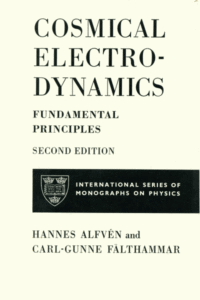
ACADEMIC BOOK
- 2nd Edition, 1963 Clarendon Press (Oxford University Press) (Out of Print)
- Reprinted from corrected sheets edition (1965)
- Buy second hand
Extract
“The purpose of the first edition of Cosmical Electrodynamics was to draw attention to a field of research in an early state of its development. The first four chapters of the book were devoted to the fundamental principles of plasma physics and magneto-hydrodynamics whereas the last three chapters treated applications to (what is now called) the magnetosphere and to interplanetary space, to solar physics, and to cosmic radiation. (The application to the cosmogonic problem was later treated in a separate book.)
“During the fifteen years which have elapsed since the first edition was written, the subject has been developed by two of the largest research efforts of our time: thermonuclear research has increased our knowledge of magneto-hydrodynamics and plasmas, and a major part of space research has been devoted to the exploration of the magnetohydrodynamic conditions in space around the earth.
“This has put the present authors in a difficult position with reference to a second edition. In order not to make the present book too thick we have confined ourselves to the fundamental principles which were covered by the first four chapters of the first edition. It is hoped that the applications will be covered by following books.
“One of the most important but also most difficult tasks of both thermonuclear research and the exploration of the magneto-hydrodynamics of space has been to establish a good contact between theory on one side and experiments or observations on the other. Therefore in this book the emphasis has been put on the physical more than on the mathematical aspect. The exactness of the derivation of a formula has often been sacrificed if this has been thought necessary in order to make the reading easier for scientists who concentrate on experiments or observations.”
The Norwegian Aurora Polaris Expedition 1902-1903 by Kristian Birkeland
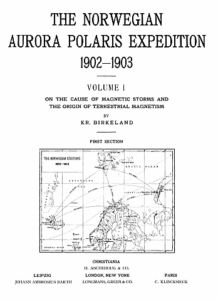
Main article: The Norwegian Aurora Polaris Expedition 1902-1903 (Book)
Publ. by H. Aschehoug & Co.
Section 1 published 1908;
Section 2 publ. 1913. Out of print.
ACADEMIC BOOK
Extract
“The experimental investigations which at first were designed to procure analogies capable of explaining phenomena on the earth, such as aurora and magnetic disturbances, were subsequently extended, as was only natural, with the object of procuring information as to the conditions under which the emission of the assumed hello-cathode rays from the sun might be supposed to take place.”
Film, video and TV
Universe – The Cosmology Quest, A film by Randall Meyers
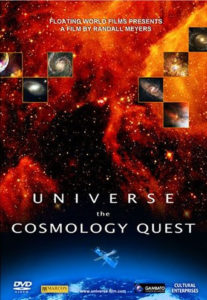
- “Universe – The Cosmology Quest” (2004) (IMDB). Directed by Randall Meyers, co-written with Eric Lerner. Buy online. Available via YouTube.
Randall Meyers writes:
- “A group of renowned cosmologists and astrophysicist are in search of a realistic picture of the universe. Their research and observational discoveries point in a direction diametrically opposed to the predominant Bog Bang theory – this leads to a series of sociological situations that verge on the extreme dogma controls wielded against Copernicus and Galileo in the past; only now against our protagonists of the 21st century. This is a controversial science documentary touching on the nerve of everything astronomers and cosmologist claim they know about the universe today”.
Featuring comments by:
|
|
Don Scott’s presentation at NASA
NASA talk: The Plasma Universe (1995)
2 hours talk titled The Plasma Universe introduced by NASA Chief Scientist Dr. France Cordova, featuring talks by Dr. James Van Allen, Dr. Ian Axford and Dr. Roger Blanford. (NASA document ID: 20040201039). Part of the conference series “To Boldly Go: America’s next era in Space”, held on Monday, Nov. 20, 1995 at NASA’s west lobby auditorium, 300 E St., SW, Washington, DC. The seminar series was initiated by NASA Chief Scientist Dr. France Anne Cordova and introduced by NASA Administrator
Daniel S. Goldin[1] Also on YouTube.
Journals
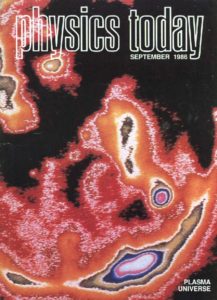
Peer reviewed articles, online in full
All peer-reviewed and available in full online:
- “Electric space: evolution of the plasma universe“FULL TEXT, Peratt, A. L. (1996)
Astrophys. Space Sci., 244, 89-103 (1996) PEER REVIEWED - “Plasma and the Universe: Large Scale Dynamics, Filamentation, and Radiation“,FULL TEXT Peratt, A. L. (1995) Astrophysics and Space Science, v. 227, p. 97-107 PEER REVIEWED
- “Cosmology in the plasma universe“. Alfven, Hannes (1988) Laser and Particle Beams (ISSN 0263-0346), vol. 6, Aug. 1988, p. 389-398. Article FULL TEXT PDF PEER REVIEWED
- “Model of the plasma universe“, Alfven, Hannes, IEEE Transactions on Plasma Science (ISSN 0093-3813), vol. PS-14, Dec. 1986, p. 629-638 Article FULL TEXT PDF PEER REVIEWED
- “Evolution of the plasma universe. I – Double radio galaxies, quasars, and extragalactic jets“, Peratt, Anthony L., IEEE Transactions on Plasma Science (ISSN 0093-3813), vol. PS-14, Dec. 1986, p. 639-660. Article FULL TEXT PDF PEER REVIEWED
- “Evolution of the plasma universe. II – The formation of systems of galaxies“, Peratt, Anthony L. (1986), IEEE Transactions on Plasma Science (ISSN 0093-3813), vol. PS-14, Dec. 1986, p. 763-778. Article FULL TEXT PDF PEER REVIEWED
- “Magnetosphere Ionosphere Interactions – Near-Earth Manifestations of the Plasma Universe“,FULL TEXT PDF Falthammar, C. G., Astrophysics and Space Science, V.144, NO. 1/2/MAY, P.105, 1988 PEER REVIEWED
- “The role of particle beams and electrical currents in the plasma universe“, Peratt, Anthony L., Laser and Particle Beams (ISSN 0263-0346), vol. 6, Aug. 1988, p. 471-491 [Article FULL TEXT PDF PEER REVIEWED
- More… FULL TEXT PDF PEER REVIEWED
Peer-reviewed articles, abstracts only
These specifically describe the Plasma Universe, but are not available in full online, but are all peer reviewed or refereed.
- The plasma universe, Alfven, H., Physics Today (ISSN 0031-9228), vol. 39, Sept. 1986, p. 22-27. Abstract PEER REVIEWED
- Model of the plasma universe, Alfven, Hannes, IEEE Transactions on Plasma Science (ISSN 0093-3813), vol. PS-14, Dec. 1986, p. 629-638. Abstract PEER REVIEWED
- Plasma universe, Alfven, Hannes, Physica Scripta (ISSN 0281-1847), vol. T18, 1987, p. 20-28. Abstract PEER REVIEWED
- Viking in the plasma universe, Alfven, H., Geophysical Research Letters (ISSN 0094-8276), vol. 14, April 1987, p. 475-478 Abstract PEER REVIEWED
- Cosmology in the plasma universe, Alfven, Hannes, Laser and Particle Beams (ISSN 0263-0346), vol. 6, Aug. 1988, p. 389-398. Abstract PEER REVIEWED
- Laboratory and near-earth space plasma as a key to the plasma universe, Falthammar, Carl-Gunne, Laser and Particle Beams (ISSN 0263-0346), vol. 6, Aug. 1988, p. 437-452. Abstract PEER REVIEWED
- Quantization effects in the plasma universe, Wells, Daniel R.; Bourouis, Mohammad, IEEE Transactions on Plasma Science (ISSN 0093-3813), vol. 17, April 1989, p. 270-281. Abstract PEER REVIEWED
- Cosmology in the plasma universe – an introductory exposition, Alfven, Hannes O. G., IEEE Transactions on Plasma Science (ISSN 0093-3813), vol. 18, Feb. 1990, p. 5-10. Abstract PEER REVIEWED
- Hubble probes the plasma universe, Lerner, Eric J., Aerospace America (ISSN 0740-722X), vol. 29, June 1991, p. 36-39. Abstract PEER REVIEWED
- Unification of gravity and electromagnetism in the plasma universe, Brandenburg, John E., IEEE Transactions on Plasma Science (ISSN 0093-3813), vol. 20, no. 6, p. 944-957. Abstract PEER REVIEWED
Journal Special Issues
- International Astronomical Union Symposium no. 6
-
- “Electromagnetic Phenomena in Cosmical Physics”, Proceedings from IAU Symposium no. 6. Edited by Bo Lehnert. (1958) Cambridge Univ. Press, 1958. (Contents and full text). FULL TEXT [2]
- Astrophysics and Space Science
-
- Vol. 55, No. 1/2/ May 1978,. “Hannes Alfvén – The First Seventy Years (Paper dedicated to Professor Hannes Alfvén on the occasion of his 70th birthday, 30 May 1978)”, Springer Netherlands, (Articles) FULL TEXT PEER REVIEWED
-
- Vol. 144, No. 1/2/ May 1988, “Special issue dedicated to Professor Hannes Alfvén on the occasion of his 80th birthday, 30 May 1988”, Springer Netherlands. (Articles) FULL TEXT PEER REVIEWED
-
- Vol. 227, No. 1/2/ May 1995, “Second IEEE International Workshop on Plasma Astrophysics and Cosmology, held from 10 to 12 May 1993 in Princeton, New Jersey. (Articles) FULL TEXT PEER REVIEWED
-
- Aug 1988: Vol 6 Part 3, “Particle Beams and Basic Phenomena in the Plasma Universe. A Special Issue in Honor of the 80th Birthday of Hannes Alfvén” (Contents) PEER REVIEWED
-
- Vol 14 No 6 (Dec 1986), Special Issue on Space and Cosmic Plasma (electrical engineering, plasma science, and the plasma universe), Contents PEER REVIEWED
-
- Vol 17 No 2 (Apr 1989), Special Issue on Space and Cosmic Plasma (golden anniversary of magnetic storms and the aurora, dedicated to Hannes Alfvén in recognition of his 80th birthday), Contents PEER REVIEWED
-
- Vol 18 No 1 (Feb 1990), Special Issue on Space and Cosmic Plasma (Plasma Cosmology), Proceedings of the IEEE International Conference on Plasma Cosmology (First Workshop on Plasma Cosmology), La Jolla, California, USA, 20-22 February 1989. Contents PEER REVIEWED
-
- Vol 20 No 6 (Dec 1992), Special Issue on Space and Cosmic Plasma (plasma experiments in the laboratory and in space.) Contents PEER REVIEWED
-
- Vol 28 No 6 (Dec 2000), 5th Special Issue on Space and Cosmic Plasma (Space Weather). Contents PEER REVIEWED
-
- Vol 31 No 6 (Dec 2004), 6th Special Issue on Space and Cosmic Plasma, Contents PEER REVIEWED
-
- Vol 35 No 4 Part 1 (Aug 2007), 7th Special Issue on Space and Cosmic Plasma, Contents PEER REVIEWED
Conferences and Workshops
-
- 1986: Double Layers in Astrophysics, Workshop held in Huntsville, Ala., 17-19 Mar. 1986 sponsored by NASA, Washington and USRA
- 1990: IEEE International Conference on Plasma Cosmology (First Workshop on Plasma Cosmology), La Jolla, California, USA, 20-22 February 1989 (See IEEE Transactions on Plasma Science, Vol 18 No 1 (Feb 1990) above)
- 1995: Second IEEE International Workshop on Plasma Astrophysics and Cosmology, held from 10 to 12 May 1993 in Princeton, New Jersey. (See Astrophysics and Space Science, Vol. 227, No. 1/2/ May 1995, above)
- European Geosciences Union (EGU) Alfvén Conferences
-
- 1996: 1st Alfvén Conference, Low-Altitude Investigation of Dayside Magnetospheric Boundary Processes, Kiruna, Sweden, 9-13 September 1996, Proceedings: Phys. Chem. Earth, Vol. 22, Nos. 7-8, 599-789, 1997 | Program
- 1999: 2nd Alfvén Conference, Auroral Particle Acceleration, Stockholm, Sweden, 3-7 May 1999, Proceedings: Phys. Chem. Earth, part C, Vol. 26, Nos. 1-3, 1-245, 2001.
- 2004: 3rd Alfvén Conference, Alfvén Waves in Space Plasmas, Steamboat Springs, CO, USA, 23-27 August 2004
- 2007. 4th Alfvén Conference, September 24-28, 2007, Arcachon, France, Palais des Congrès
- 2010. 5th Alfvén Conference, 4-8 October 2010, Plasma Interaction with Non-Magnetized Planets/Moons and its Influence on Planetary Evolution, Sapporo, Japan (Publications)
- 2014. 6th Alfvén Conference. Plasma Interactions with Solar System Objects. Anticipating Rosetta, Maven and Mars Orbiter Missions. University College London. 7-11 July 2014
Footnotes
- ↑ NASA Press Release, 1995
- ↑ Winston H. Bostick, “Stockholm, August 1956, Revisited” (1989) IEEE Transactions on Plasma Science Volume: 17, Issue: 2 pp. 69-72. “Much of the modern-day foundations of the plasma universe can be traced to the International Astronomical Union Symposium number 6 held in August 1956, in Stockholm